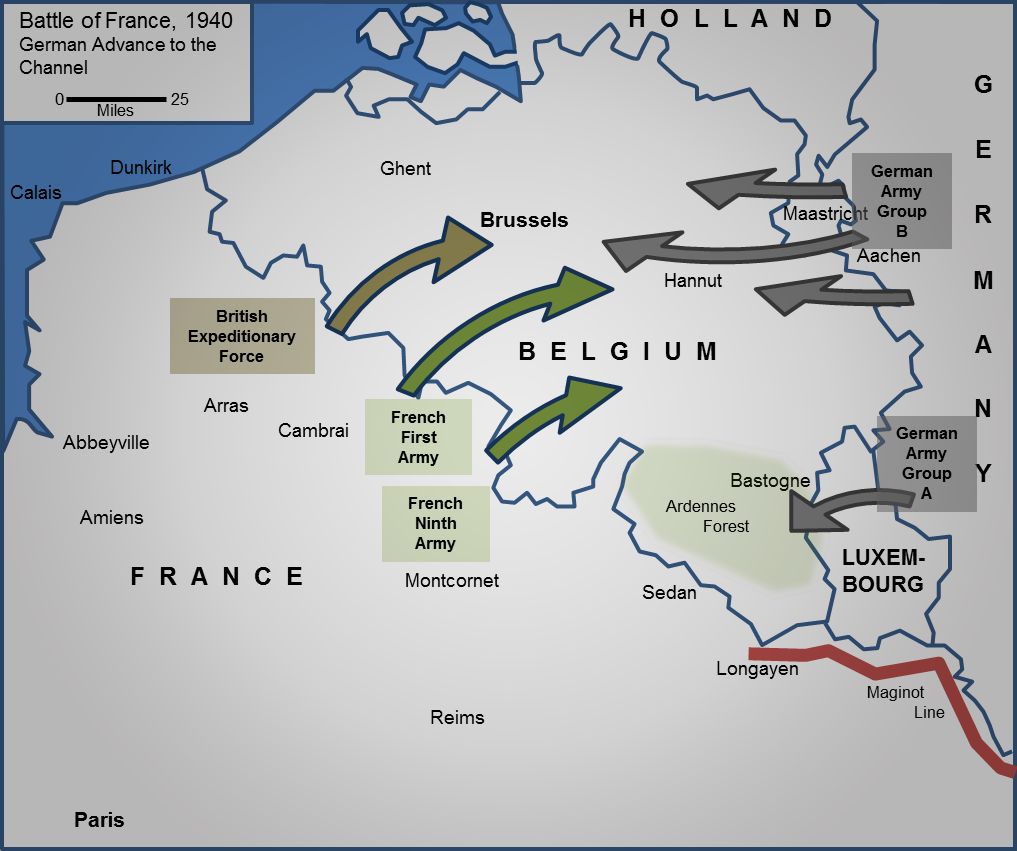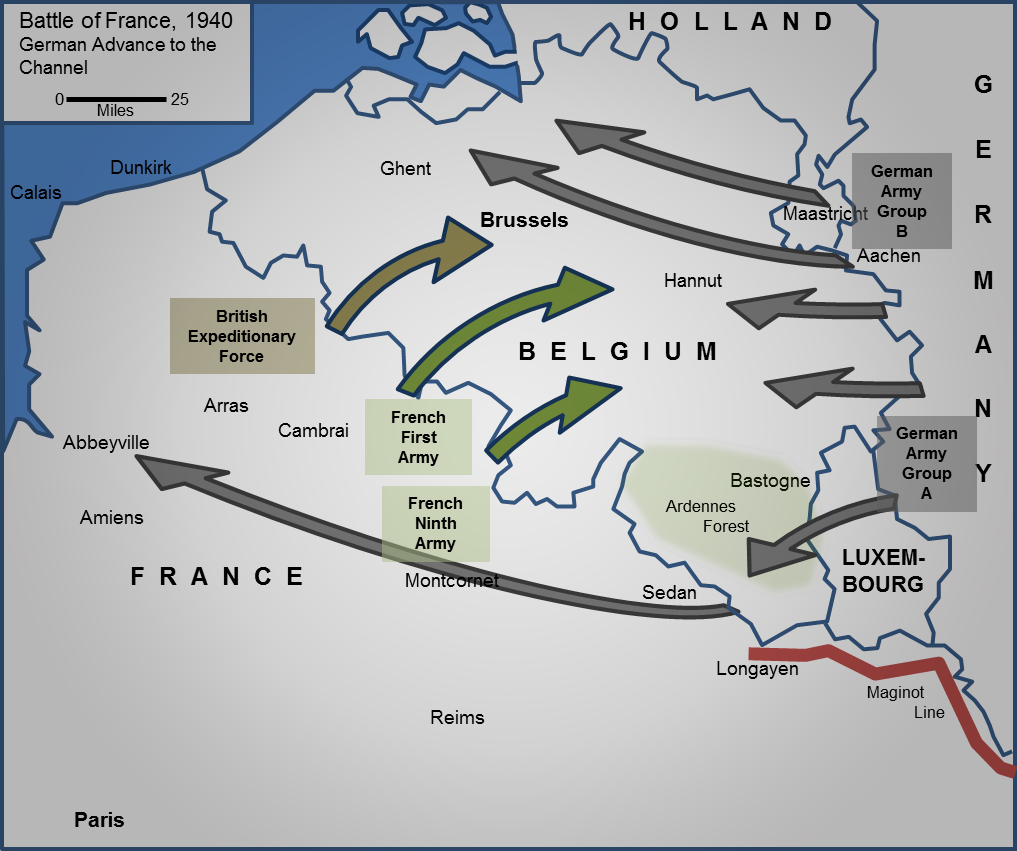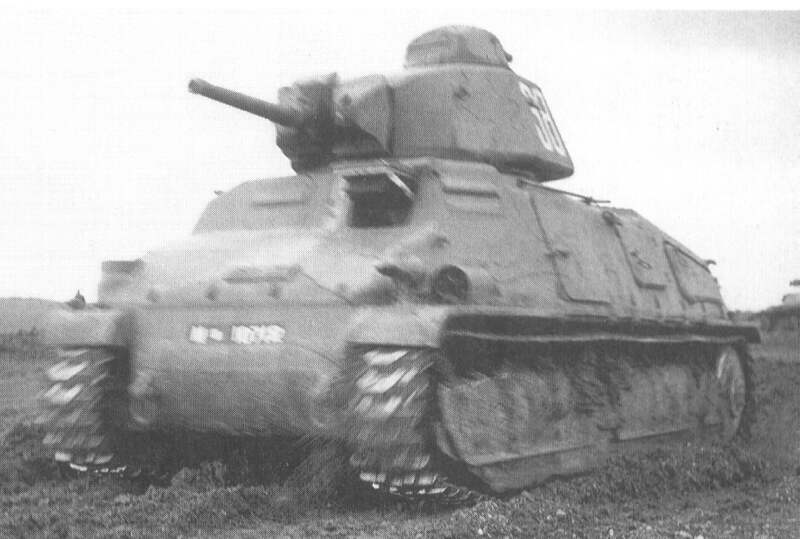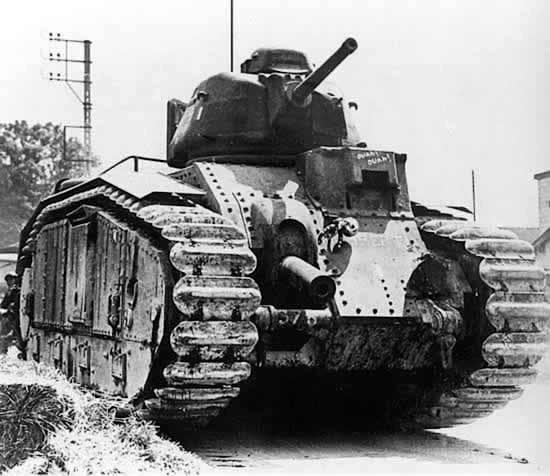World of Tanks news » The Chieftain's Hatch: French Armor In 1940

I am pleased to again hand off the keyboard to a guest writer and to see the return of author Mark Singer.
FRENCH ARMOR IN 1940
It is one of the great axioms of military tactics that the initial deployment of forces is 50% of the battle. Deploy your forces well, and you spend less time reacting to your enemy, and more time forcing your enemy to react to you. In order to maximize the potential for an appropriate initial deployment, the commander must learn to envision the coming clash, to understand how it might ebb and flow.
The story of French armor includes several tanks with solid armor and comparatively good guns, organized into large combined arms formations that offered tremendous potential. It also includes several ill-conceived features in tank design, and a hierarchy of design, procurement and command personnel who quite simply failed to envision the nature of armored combat.
The French fought the Germans in history’s first large-scale tank battles in May of 1940. French tanks earned a reputation as tough adversaries. Yet history remembers little of this. History remembers the innovation and panache of the victorious Germans. But the student of military history can learn much from exploring the experiences of the French.
OVERVIEW OF THE BATTLE OF FRANCE, 1940
The campaign of 1940 was the greatest disaster in French military history. Many historians have sought the causes of, or the explanations for this great debacle. But it can be reasonably well understood simply on the basis of the two basic principles described above. The French high command did not correctly envision the battle that was coming, and so their initial deployment put them at a great disadvantage – it was a matter of tactical axioms, writ on a national scale.
Interestingly, the French High Command had envisioned that armor would play a key role in any clash along their borders. Some people see the French efforts in construction of a fortified frontier zone, the Maginot Line, as a failure to grasp the importance of armored formations. However, any review of the order of battle of the French Army shows that the French foresaw armor playing a key role in any military clash.
The Maginot Line was an economy-of-force effort. Using a small percentage of their available combat manpower, the French secured their entire border with Germany. Even the Germans recognized the effectiveness of the Maginot Line, choosing to avoid attacking on the direct route, instead marching through Holland and Belgium in order to reach an unfortified French border.
The German strategy played on French expectations almost perfectly.
The Belgians and the Dutch were somewhat less enthusiastic about this plan.
They worked with the French on joint warplans in the 1930s. But when France and Britain declared war against Germany over the invasion of Poland in September of 1939, both Holland and Belgium opted out. To avoid appearing belligerent towards the Germans, and to bolster their claims to neutrality in the conflict, they did not allow the French and British armies to cross into their territory to take up the positions that joint warplans had called for.
But Germany cared nothing about the Dutch and Belgian efforts at neutrality. When they were ready to launch their war in the west in May of 1940, the Germans aggressively attacked Holland and Belgium with Army Group B, a powerful combined arms force spearheaded by three of Germany’s vaunted Panzer (armored) Divisions. German bombers and parachutists prepared the way for the panzers and the infantry, who swept the Dutch and Belgian forces away as they advanced.

Map 1: The German attack started in the north, with Army Group B moving through Holland and Belgium.
As planned, the French and British advanced into Belgium. But rather than fighting from prepared defensive lines as they had planned, they wound up fighting a series of very large meeting engagements, pitting their own forces against the mobile warfare skills of the Germans.
The French in particular has several powerful mobile units that rapidly advanced to contact, fighting a series of sharp engagements to delay the Germans and give their own infantry divisions time to advance and take up positions. The largest tank battles the world had seen to that point were the result.
For all of their efforts, the French and British could not stop the advance of Army Group B. The Germans continued to advance (albeit at a modest pace), the Dutch and Belgian armies collapsed, and casualties mounted on all sides.
However, in the end the fight to block the advance by Army Group B was actually nothing more than a side-show. The more deeply the French and British engaged, the deeper their peril became. Because the key to the German war plans was not Army Group B, but Army Group A. During this time, Army Group A, a highly mechanized formation with seven of Germany’s Panzer Divisions, had moved across Luxembourg and into the Ardennes Forest of southern Belgium. Sweeping aside the cavalry screens of this thinly defended sector, they burst forth to cross the Meuse River into France near the city of Sedan.

MAP 2: Once across the Meuse at Sedan, Army Group A advanced at a break-neck pace to the Channel at Abbeyville, encircling the cream of the allies’ armies.
After crossing the Meuse, the Panzers of Army Group A were turned loose, racing all the way to the Channel coast. Fully engaged against Army Group B, within two weeks of the start of the campaign the bulk of France’s mobile forces and virtually the entire British Expeditionary Force found themselves encircled.
The only course available was a precipitous retreat to the coast, and a mass evacuation through the port of Dunkirk. The campaign in France would continue for four more weeks. But the best of the French forces lost their heavy equipment in a fighting retreat across Belgium, or left it on the beaches. Those French forces that managed to evacuate through Dunkirk returned to France empty-handed.
THE TANKS OF THE FRENCH ARMY IN 1940
France operated a variety of major and minor tank types in 1940. The French Army mustered over 3,200 tanks for the 1940 campaign, while the British and Belgians added a few of their own to the total allied tank count. In comparison, the Germans brought only about 2,400 Panzers to the campaign in the west.
The most common tank in the French Army in 1940 was the Renault R35. It was a small, inexpensive 2-man light tank that was built in very large numbers. For its size and weight it had surprisingly good armor, with rounded cast shaping that helped deflect armor piercing rounds. It was designed to meet a French Army requirement for an infantry support tank. The speed was not much greater than that of a foot soldier, and the turret carried a low-velocity 37mm gun that was based on the man-portable trench gun then in use in French infantry divisions. As such it was really little better than a grenade launcher. For reducing machine gun positions that might block the infantry’s advance, that was enough.
The Hotchkiss H35 was similar. There was little to choose from between these two tanks. The Hotchkiss was marginally larger, and a little faster, but not enough to make a difference. The capabilities of the two tanks were the same. They even looked alike – both using the same turret, the same type of suspension (although the R35 had one fewer roadwheel per side), and a similar cast hull with rounded corners. Yet the Hotchkiss was categorized as a cavalry tank rather than an infantry tank.
The Hotchkiss design was upgraded with a new larger engine, providing a top speed above 20kph and making the tank entirely more useful. This upgrade is sometimes revered to as the H38, and sometimes as the H39. Neither are technically correct, as the tank was still an H35. The proper term was H35 modifié 1938/39. But for common usage the terms H38 or H39 are interchangeable.

Six roadwheels per side identifies this French tank as a Hotchkiss rather than a Renault light tank. The flat engine deck, indicating a larger engine compartment, further identifies it as an H39. Note, though, that it retains the short 37mm gun of the earlier H35 model.
An upgrade to the short 37mm gun was also made available at about this time. The new SA-38 gun had modest velocity, versus the anemic velocity of the earlier SA-18. The new gun had significantly better anti-armor performance, but it was still far behind the best British, German, or even French AT guns. But there were never enough SA-38 guns to go around, and so in many cases they only equipped the platoon, company or battalion-commanders’ tanks.
The combination of larger engine and new longer gun made the H-39 a more capable tank. The French Army was impressed enough to select it as the primary light tank for new production, both for the cavalry and for the infantry. The fall of France, in the summer of 1940, interfered with this plan.

The Somua S35 had a good turn of speed for a 1940 tank with such high levels of protection and gunpower.
The Somua S35 was the cavalry’s main combat tank. It was fast for its size, had good armor, and a good 47mm mid-velocity gun. Its nearest competitor on the German side was the Pz III. The –F and –G versions of the Pz III were just coming in to the Panzer forces at this time, armed with a 37mm medium-velocity cannon. In comparison the S35 had significantly better armor, a better gun, and was nearly as fast on the battlefield.
The Char-B was the heaviest tank in widespread service in 1940. In French terms it was a Chars de Combat, a battle tank, for the infantry branch. It was designed for the role of advancing against prepared defenses. The Germans found it dangerous and hard to knock out, giving it the nickname “leviathan”. In the Char-B1bis configuration, the most common in service by May of 1940, it mounted the same 47mm gun in its turret as the S35. It also mounted a 75mm howitzer in the hull. The frontal armor, at a basis of 65mm, was the heaviest armor of any tank fighting in Western Europe at that time. It was an interesting vehicle, with a mix of very conservative and very innovative features.

The Char-B1bis was the heaviest tank in service in Western Europe in 1940. Archaic in overall shape, it none-the-less had several modern features.
The overall shape of the hull, with slab sides and the track running full height around the hull, was a design characteristic that reached back to the first world war. Yet the drive train and differential had the capability to neutral-steer, a rare capability in WW2 tanks. It was a feature that was meant to be used, too, as the only way to aim the 75mm hull gun was by turning the tank. This meant the driver of the Char-B was also the gunner for the 75mm gun! If that gun was not enough for him, the driver also controlled 2 remotely fired machine guns fixed in the front hull, which were also aimed (after a fashion) by turning the tank. The 75mm gun also had a forced air bore evacuator, a feature seen in almost no other WW2 era tank.
These tanks, the R35, H35 and 39, the S35 and the Char-B, were the main tanks in service in the French Army. But there were about a dozen other designs that were present in small numbers of a few dozen up to perhaps 100 copies.
The cavalry had a series of light tanks referred to as armored cars (“automitrailleus” or machine-gun cars). This term was used to label any armored vehicle of the cavalry. AMCs (automitrailleus de combat) were made for combat in support of mobile forces. AMRs (automitrailleus de reconnaissance) were designed to be scouting vehicles. The AMR-33 and -35 were present in some numbers, but the AMC-34 and -35 never made it into French service. The AMC-35 was in fact adopted by Belgium as their only real battle tanks, while in French formations the role of the AMC was taken by H35s and H39s in most cases.
Among infantry tanks there were obsolescent Renault D-1 and D-2 models which had pre-dated the R35 and Char-B, and the brand-new Renault R40, a substantial redesign of the R35 which entered production about the same time as the H39, but lost out in the competition to be the new single light tank for both infantry and cavalry.
There were several design issues that were common across many French tanks, which had significant impact on their combat efficiency. The first was the tendency to 1-man turrets. The R35, H35 and 39, and the Char-B all had one-man turrets, in which the commander acted not only as the gunner but also the loader, all the while being responsible also for observing the course of the battle, giving instructions to other crewmembers, and keeping track of any superior or subordinate tanks. The S35 had a crewmember who could be referred to as a loader, but it still had a one-man turret! The loader stayed in the hull of the tank, and handed rounds of ammunition up to the commander in the turret.
These one-man turrets in most cases had cupolas with all-round vision devices. It would have been exceedingly difficult for a tank commander to find the time to move his head into the cupola for a look around when actually engaged in combat, as he was also finding the ammunition, loading, as well as aiming and firing the gun. Oddly, commanders’ cupolas did not have hatches on French tanks. The standard hatch on a French tank was a panel on the rear of the turret which hinged downwards. When open, the hatch itself served as a seat for the commander, who could then ride with more than 50% of his body out of the tank, sitting on the hatch, with his legs dangling inside. This was probably quite reasonable on a road march. But it was entirely impractical during combat.
Another design issue affecting combat efficiency was the lack of radios. Light tanks like the R35 carried no radios. In larger tanks such as the S35, only command tanks had radios. Only the Char-B carried a radio in each tank. And when radios were present, they were often keyed morse-code radios rather than radio telephones. This allowed greater range perhaps, but made it impractical to communicate tactically during combat.
The result of these characteristics was that French tanks tended to fight their own private battles, even when they were fighting alongside their comrades-in-arms. The French had envisioned tank battles as set-piece affairs, where orders would be received over the radio from higher headquarters, unit commanders would brief all subordinates, and then each tank would fight independently to achieve its own part of the plan. Once in battle, tank commanders and formation commanders did precious little in the way of commanding. Rather, they were busy managing their tanks’ weapons.
This fit with French Army doctrine on command and control. The concept of the “Methodical Battle” dominated French military thinking in the post WW1 era. Units were to maneuver in well-rehearsed formations at a slow enough pace that great concentrations of artillery could fire deliberate rolling bombardments just in front of advancing French troops. Junior officers were there to ensure the troops remained in coherent formations and followed the plan, not to exercise individual initiative.
The French Army’s hierarchy had clearly failed to envision the swirling, fast-paced ad hoc nature of armored warfare. German panzers, clearly outnumbered on an operational scale, consistently outmaneuvered the slower, heavier French tanks with their isolated over-worked commanders. They concentrated faster to create local superiority in numbers, concentrated unit fires on specific tanks or even specific parts of tanks, and adjusted their unit formations and even unit organizations on-the-fly. French tanks wound up out-numbered and out-flanked. That is not a recipe for success.
FRENCH FORMATIONS: AHEAD OF THEIR DOCTRINE
The French are often accused of doling out their armor in penny-packets in 1940. But while they had no separate armored branch, in fact the French had several combined arms division structures with substantial numbers of tanks in both the cavalry and infantry branches.
A great number of tanks were organized into independent tank battalions. These were held at army HQs as reserves to be provided to infantry divisions on an as-needed basis. Each independent battalion would typically have a single type of tank. The R35 was the most numerous, the H35 was also common, and several battalions were equipped with older or less common types. Most battalions were administered under groups of battalions -- Groupement de Battalion des Chars, or GBCs. GBCs frequently controlled more than one type of tank battalion. At the start of the battle of France there were 16 GBCs with a total of 35 independent tank battalions deployed with the armies in metropolitan France. A typical battalion would have 45 tanks, but if the tank type was older, or in limited supply, that number might vary. The independent battalions were pure tank formations, with no infantry or artillery assets. It was expected they would be assigned to infantry divisions for combat.
The independent battalions were a reasonable idea, intended to provide tank support to infantry units that might not otherwise have access to this critical weapon. However, the very independence of the tank battalions meant that cross-training between formations was rare. Most infantry were not familiar with tanks, and the independent tank battalions seldom saw infantry except at a distance.
But there were several well balanced combined arms formations in the French army. The most notable were the Divisions Léger Mécanique, or DLMs. These were powerful and highly mobile formations that compared well with the German Panzer Divisions.
The heart of the DLM was three combat regiments: two of tanks, and one of dragoons (dragons portés – mounted infantry). The tank regiments each fielded two battalions of S35s and two battalions of H35 or H39 tanks (1st and 2nd DLMs had H35s, 3rd and 4th DLMs had H39s), for a total of 96 S35s and 94 H35/39s for each DLM. The Dragoons were mounted in all-terrain Laffley trucks, and had their own armor in the form of a squadron (company) of 21 AMR33/35 recon tanks, which were replaced by even more H39s in the 3rd DLM. The Dragoons also had their own 25mm AT guns, in addition to the more powerful 47mm AT guns in the divisional AT battery.
The DLM also had a recon regiment (Regiment de Decouverte) which operated the excellent Panhard P178 AMD armored cars equipped with 25mm cannons, and an artillery regiment with 24 x 75mm guns and 12 x 105mm guns. The division also had its own small squadron of army cooperation planes (typically Mureaux 117s and Potez 63.11s). All in all, it was a very powerful and highly mobile formation.

The French title of the division – Division Léger Mécanique – is often translated as Light Mechanized Division. That is incorrect. In French the modifier generally comes after the noun, so the words Léger Mécanique translate more correctly as Mechanized Light rather than Light Mechanized. Understanding this subtle difference allows a quicker grasp of the French intentions for the DLMs. These were not seen as mechanized divisions, but rather as light divisions. The French Army operated two forms of “Light” Divisions – the DLM (Mechanized) and the DLC (Horse Cavalry). “Light” formations in cavalry had combat roles that were clearly established and understood from Napoleonic times. So even though the DLMs were very powerful formations, they should be understood first and foremost as mobile formations intended to screen, delay, or exploit rather than as heavy combat formations.
The other Light divisions were the DLCs – Light Cavalry Divisions. While the implication may seem to be a horse-based division, this was in fact a hybrid organization. The DLCs were based on a horse cavalry brigade and a mechanized light brigade. The mech light brigade had an armored care regiment with two battalion-sized “groupements”, one of combat cars (AMC) and one of scout cars (AMD). The intention was to equip the combat car battalions with the fully tracked AMC35 light tank. But this vehicle was never acquired by the French. So when the time came to assemble the formations together into the DLC divisions, the combat car battalions were equipped with H35s.

The Dragon Portés (mounted infantry) of the DLC Mech Light brigades were carried in Citroen halftracks vs. the Laffley all-wheel drive truck mounts of the Dragons Portés of the DLMs. As with the DLMs, the DLC Dragon Portés had their own 25mm AT guns, bolstered by the 47mm AT guns of the divisional AT battery. The Dragon Portés also had their own armor, in the form of two platoons of AMR-33/35 reconnaissance cars. These were fully-tracked light tanks armed with machine guns.
So while the name Cavalry Light Division may have implied a division without tanks, in fact the DLCs had 15 H35 tanks and 23 AMR33/35 light tanks, as well as another 16 wheeled armored cars. It also operated its own small squadron of army cooperation aircraft. So for a horse cavalry unit it was indeed a bit of a combined arms force – a hybrid between animal power and mechanization, at the very least.
For the French, heavy combat meant the infantry branch. And when the going was expected to involve a breakthrough operation, the infantry had their Divisions Cuirassier de Reserve (DCRs). The translation of this unit title is even more challenging. Cuirassiers were the traditional French heavy cavalry. The name is a reference to the armored breastplates that they wore, which may have influenced the naming of the division. But perhaps more importantly the Cuirassiers were a force that did combat by shock action, riding into the enemy and breaking his formations. The reference to reserve implies only that it to be held at the Army level, much like the independent tank battalions, rather than being assigned as part of any particular corps as an infantry division would. So even though they were part of the French Army’s infantry branch rather than the cavalry, a proper translation of DCR might be an Independent Heavy Cavalry Division. However, for the sake of clarity these can be thought of simply as Armored Divisions, and the French Army today traces the unit histories of their armored divisions to the DCRs of 1940.
It is worth noting that the French concept of an armored division in 1940 was exclusively as a breakthrough force. The bold race to the channel that the Panzer Divisions of Army Group A achieved was nowhere to be found in French military thinking, and was far beyond the capabilities of the DCRs even if it had been considered.
The heart of the DCR was four tank battalions, organized as two half-brigades. A DCR’s heavy half-brigade operated 68 Char-B tanks, while its light half-brigade operated 90 H39s (except for the 4th DCR, which was equipped with R35s in its light half-brigade).

Notably absent from the organization of the DCR are any reconnaissance elements. Other than the aerial observation group, the DCR had no means of finding, much less fixing the enemy.
The Artillery Regiments of the DCRs eschewed the lighter 75mm guns that were found in other formations. DCRs were equipped exclusively with heavier 105mm guns (again except the 4th DCR, which was thrown together with whatever was available in May of 1940, and wound up with 75mm guns).
All of this points to the purpose of the DCR – as a breakthrough force. It was not expected to find the enemy because the enemy’s location should have been well known before a DCR was called in to action. So also larger guns were the order of the day, for their superior ability to root out enemies who have dug-in.
In the event, however, there were no fortifications for the DCRs to batter. They were used in hasty counter-attacks against highly mobile German forces, a purpose to which they were ill-suited.
The final formation that bears examination is the Motorized Infantry Division (DIM). Seven DIMs formed the core of the armies that advanced into Belgium behind the screen of the DLMs to try to build a defensive line to contain Army Group B.

Of the many different formation types in the French Army, the DIMs are worth mentioning here for two reasons. First, at least two of the DIMs that moved into Belgium were equipped with Hotchkiss tanks in their AMR squadrons (H39s in the 9th DIM, and H35s in the 25th DIM). Thus these are the last division-sized units to be examined that were equipped with tanks. But as importantly, a look at the organization of the DIM reveals again the focus of France’s warfighting doctrine. When heavy combat is the focus of your formation, then artillery, and lots of it, should be the focus of your operation.
SUMMARY
On many levels, the French high command failed to envision the nature of the war that broke over their country in May of 1940. Leading what was reputed to be the most powerful army on earth, they put much imaginative thinking into the development of new armored vehicles and all-arms formations. But they did not apply enough creativity to the question of how modern arms would change the face of war.
French tanks outnumbered German tanks. They had superior armor and in many cases better guns. Yet the cream of France’s Army had been encircled and effectively destroyed after only 2 weeks of fighting. The Germans were engaging in mobile warfare, and the French had not anticipated how mechanized forces could change the tempo of operations. They were out of place, and once German forces got past them, there was nothing the French could do to catch up.
Even when French armor met German armor head-to-head, as in the Belgian plains at the Gembleaux gap (near the town of Hannut), French armor, while bravely led, could not stem the tide of the German advance. The French had not only deployed their forces based on a mis-reading of the battle to come, they had also developed their tanks with a mis-reading of the battle to come.
As a simple mind excersize, consider this: to get some level of appreciation for the realities of French armor in 1940 through the World-of-Tanks game, you might:
a) Turn off all maps for French players. Also turn off chat. You have no radio, and very poor situational awareness because you can’t get your head out of a hatch to look around.
b) Now, every time you fire your cannon, take your eyes off of your PC screen until you hear the sound indicating your gun has finished cycling. Now go find your target and fire.
How do you think you would do? Even if you had the top tier tank in your game, how do you think you would do?
It is often said that tank design is a question of balancing protection, firepower, and mobility.
The French had a good hand on the armor issue and had tanks with ample protection. They did a credible job on guns, sites, and ammunition, too, giving their leading tank designs good firepower. But they did not envision the impact that mobility would have on the battlefield. Interestingly it was less the speed of the tanks, and more the speed of communications and reaction, that marked the doom of French armor in 1940.















 Update comments
Update comments